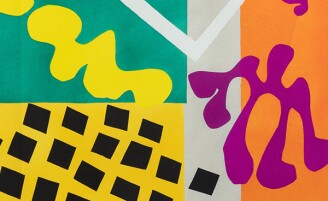T his seminal work marks a creative milestone in Matisse’s later life which cannot be ignored—his pioneering use of the paper cut-out as a medium rather than a compositional tool. Jazz, published in 1947, is a strangely hypnotic artist’s portfolio book made up of 20 plates illustrating not jazz music, but the circus—with its undertones of life on the road—and the artist’s own earlier travels. The ‘jazz’ element can instead be found in the improvisational techniques seen throughout the book, connecting expressionist art and the musical improvisation found in jazz.
A majority of the plates were created during a period commencing in 1941, after a life-saving surgery to alleviate duodenal cancer saw Matisse chair- and bedridden for many months. A lack of mobility that hindered both his sculpting and painting, and which resulted in him ‘drawing’ with scissors using vividly pre-painted paper to create decoupage, or cut paper collage. And while this was not the first time Matisse had used decoupage in his work, it marks a shift from painting and sculpture to his final medium, one that he used until his death in 1954.
Matisse said that the “paper cut-out allows me to draw in colour. It is, for me, a matter of simplification ... I draw directly into the colour, which is all the more controlled in that it is not transposed. This simplification guarantees a precision in the reunion of the two means, which brings them together as one.”
An aspect of the series that seems truly groundbreaking is that when Matisse created them, they weren’t necessarily permanent compositions—the individual moveable pieces were pinned to create the perfect image using trial and error, testament to Matisse’s seemingly infinite patience. They could be changed, if he didn’t feel they were correct, at least until the stencilling.
The stencil technique itself, known as pochoir, was also a labour-intensive process that took a lot of skill. This job was entrusted to Edmond Vairel, who created the stencils from Matisse’s final compositions. The stencils were then painted with the same vibrant gouaches used by Matisse’s assistants and printed. Matisse’s handwritten thoughts and poetry notes on the process were printed by Draeger Freres, then added to the final books to evoke the sense of a musical composition’s rhythm and repetition.
Matisse was captivated by the layers and irregularity of texture the paper maquettes, and the originals with their paper-layered-on-paper depth, which he referred to as the ‘sensitivity’ of the designs. When the book was finally released and published by Tériade in a small batch of 250, though some of the original texture was altered, Matisse soon came around to the beauty of the end product — his original idea in its new guise.
The finished article is a beautifully crafted collection of prints, giving the viewer the opportunity to realise the process Matisse went through, and with it, his deep exploration of form and colour. The images encapsulate his continued use of technically-innovative processes, his intellectual and emotional depth, and ultimately offer a chance to experience a more personal side to Matisse through the thematic decisions he made.







